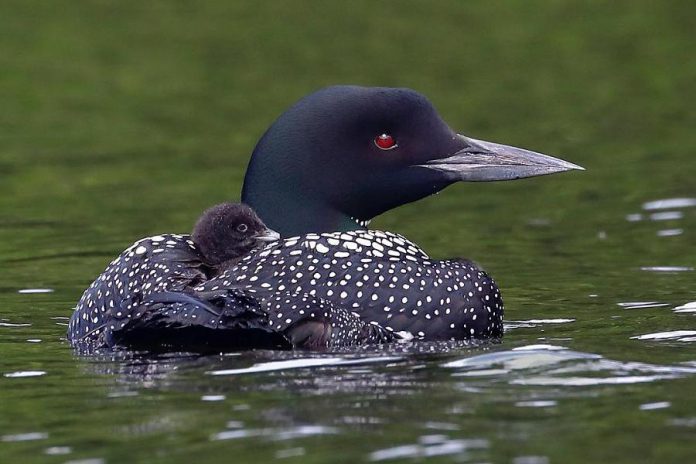
Photographer Cliff Homewood has captured some amazing shots of a pair of loons as they raise their newborn chicks. He’s been posting updates in his Instagram feed over the past week, where they caught our attention.
In case you’re concerned, Cliff — an experienced wildlife photographer — has been taking the photos very carefully as to not disturb the loons or their chicks.
“We’ve known this loon pair for many years and they are used to us observing them,” Cliff writes on Instagram. “As long as we keep our distance, move slowly and don’t outstay our welcome they ignore us.”
As you look at Cliff’s photos below, it helps to know a bit about how loons are born and raised. After a pair of loons mate, they build their nest clost to water — on the edge a small island or a half-submerged log for example — and they’ll often use the same sites from year to year. Both the male and female help with nest building, using mud, grass, and other vegetation. The female will lay usually one or two eggs in late May or June, with the eggs incubating for almost a month.
In late June or early July, the eggs hatch and the chicks emerge, covered in brownish black down. They can swim right away, but will spend time riding on their parents’ backs to conserve energy and to avoid predators like large fish, birds, and snapping turtles. Their parents feed them minnows and insects during their first few weeks of life. After about two months, the chicks begin to dive for some of their own food. By three months, they are catching almost all of their own food and are able to fly. By early fall, the young loons are able to look after themselves completely.
Here are Cliff’s photos of the loons. We’ll update this story with new photos as Cliff posts them on Instagram, or you can follow his Instagram feed yourself @kerrybrook (he shares a lot of wonderful photos of wildlife and nature). Cliff also owns and operates Kerrybrook Web Design at kerrybrookwebdesign.ca.
Check back over the next few weeks as we update this story with more photos from Cliff.
Sunday, August 6
He still doesn’t look like an adult loon, but all that fish is helping the chick grow.
Friday, August 4
One of the adult loons catching her own fish. According to Cliff, the parents are still catching only small fish for their chick.
Thursday, July 27
The loon chick is now able to eat food on his own, but he’s not catching it yet.
Sunday, July 23
It looks like the surviving loon chick has grown a lot in the last few days. Here he is trying to eat a meal on his own.
Thursday, July 20
Here’s the sole surviving chick with mama loon.
Tuesday, July 18
Some sad news to report: one of the loon chicks pictured in the photo didn’t survive the past week.
Friday, July 14
One of the chicks riding on mama’s back, while looking back at papa loon (not pictured) who is catching fish.
Tuesday, July 11
Mama loon with one of her chicks (the other is under her wing).
Monday, July 10
Papa loon takes a break from constant feeding of the chicks to feed himself.
Friday, July 7
The two loon chicks. At this age, covered with brownish-black down, they don’t look like loons at all.
Wednesday, July 5
Papa loon feeding one of the chicks; the other chick is tucked under the mother’s other wing.
Tuesday, July 4
One of the chicks on mama’s back, with the other — hatched only hours before — tucked under a wing (he’s barely visible).
Monday, July 3
One chick is hatched, while mama loon turns her second egg which is about to hatch.
Sunday, July 2
Cliff in his kayak taking a photo of mama loon on her nest.
Saturday, June 17
Here’s mama loon on her nest, incubating her eggs.
Friday, June 16
Here’s one of the loons (we’re not sure if it’s mama or papa) before the chicks were born, catching a fish.


























